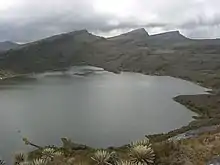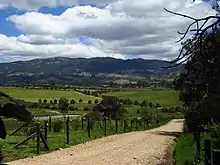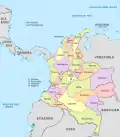Cundinamarca Department
Department of Cundinamarca (Departamento de Cundinamarca, Spanish pronunciation: [kundinaˈmaɾka]) is one of the departments of Colombia. Its area covers 22,623 square kilometres (8,735 sq mi) (not including the Capital District) and it has a population of 2,919,060 as of 2018. It was created on August 5, 1886 under the constitutional terms presented on the same year. Cundinamarca is located in the center of Colombia.
Cundinamarca Department
Departamento de Cundinamarca | |
|---|---|
 Flag  Coat of arms | |
| Motto(s): Cundinamarca Corazón de Colombia (Spanish: Cundinamarca, Heart of Colombia) | |
| Anthem: Himno de Cundinamarca | |
.svg.png.webp) Cundinamarca is shown in red | |
 Topography of the department | |
| Coordinates: 5°00′00″N 74°10′00″W | |
| Country | |
| Region | Andean Region |
| Established | June 15, 1857 |
| Capital | Bogotá |
| Government | |
| • Governor | Nicolás García Bustos (2020-2023) |
| Area | |
| • Total | 22,623 km2 (8,735 sq mi) |
| • Rank | 17th |
| Elevation | 3,341 m (10,961 ft) |
| Population (2020)[3] | |
| • Total | 3,242,999 |
| • Rank | 4th |
| • Density | 140/km2 (370/sq mi) |
| Time zone | UTC-05 |
| ISO 3166 code | CO-CUN |
| Provinces | 15 |
| HDI (2019) | 0.774[4] high · 9th of 33 |
| Website | Official website |
Cundinamarca's capital city is Bogotá, the capital of Colombia. This is a special case among Colombian departments, since Bogotá is not legally a part of Cundinamarca, yet it is the only department that has its capital designated by the Constitution (if the capital were to be ever moved, it would take a constitutional reform to do so, instead of a simple ordinance passed by the Cundinamarca Assembly). In censuses, the populations for Bogotá and Cundinamarca are tabulated separately; otherwise, Cundinamarca's population would total over 10 million.
| Entity | Population | Area (km2) | Area (square miles) | Density (per km2) | Density (per sq.mi.) |
|---|---|---|---|---|---|
| Cundinamarca (without Bogotá) | 2,919,060 | 22,623 | 8,735 | 129 | 334 |
| Bogotá | 7,412,566 | 1,587 | 613 | 4,671 | 12,092 |
| Cundinamarca and Bogotá | 10,331,626 | 24,210 | 9,348 | 427 | 1,105 |
Etymology
The name of Cundinamarca comes from Kuntur marqa, an indigenous expression, probably derived from Quechuan and means "condor's nest".[5][6][7]
Geography
Most of Cundinamarca is on the Eastern Cordillera (Cordillera Oriental), just south of Boyacá, bordered by the Magdalena River on the west, reaching down into the Orinoco River basin on the east, and bordering on Tolima to the south. The capital district of Bogotá is nearly completely surrounded by Cundinamarca territory and was formed by carving up Cundinamarca. Because of this and other border changes, the present department of Cundinamarca is much smaller than the original state.
Demography and ethnography
| Year | Pop. | ±% |
|---|---|---|
| 1973 | 1,125,642 | — |
| 1985 | 1,512,928 | +34.4% |
| 1993 | 1,875,337 | +24.0% |
| 2005 | 2,280,037 | +21.6% |
| 2018 | 2,919,060 | +28.0% |
| Source:[8] | ||
Municipal population position
According to the latest census conducted in 2005, 2,280,037 people live in Cundinamarca, excluding 6,776,009 of the capital, Bogotá. The racial makeup is:
- Whites and mestizos (96.28%): Mestizos are mixed European-Amerindian blood. The Bogotá metropolitan area has a history of European (not limited to Spanish) and other Latin American immigration.
- Blacks or Afro-Colombians (3.33-3.37%)
- Indigenous/Amerindians (0.31-0.34%)
- Roma (Gitanos or Gypsies) (0.01%)
- East Asians (0.01%), often of Chinese descent. About 25,000 Chinese-Colombians live in the department.
The city of Bogotá and the municipalities of Soacha, La Calera, Cota, Chía, Madrid, Funza, Mosquera, Fusagasugá, Facatativá and Zipaquirá form a single metropolitan area.
| Rank | City or municipality | Inhabitants (1985) |
Inhabitants (1993) |
Inhabitants (2005) |
Inhabitants (2015)* |
Inhabitants (2020)* |
|---|---|---|---|---|---|---|
| 1 | Soacha | 132,758 | 254,625 | 401,996 | 511,262 | 567,546 |
| 2 | Fusagasugá | 63,886 | 82,003 | 108,949 | 134,523 | 147,631 |
| 3 | Facatativá | 55,324 | 75,711 | 107,463 | 132,106 | 144,149 |
| 4 | Zipaquirá | 60,202 | 75,166 | 101,562 | 122,347 | 132,419 |
| 5 | Chía | 38,862 | 55,742 | 97,907 | 126,647 | 141,917 |
| 6 | Girardot | 81,019 | 90,904 | 97,889 | 105,085 | 107,796 |
| 7 | Mosquera | 16,505 | 22,250 | 63,237 | 82,750 | 93,461 |
| 8 | Madrid | 33,795 | 42,584 | 62,436 | 77,627 | 85,090 |
| 9 | Funza | 31,366 | 41,119 | 61,391 | 75,350 | 82,321 |
| 10 | Cajicá | 23,618 | 31,316 | 45,391 | 56,875 | 62,713 |
| Source: DANE *projection[9] | ||||||
Important cities
Cundinamarca is made up of 116 municipalities, six of which recorded a population of over 100,000 and could be considered as cities: Soacha, Fusagasugá, Girardot, Facatativá, Zipaquirá and Chia, while Bogotá District is in the category of capital.

- Metropolitan Area of Bogotá: Comprises the towns of Soacha, Facatativá, Chia, Madrid, Funza, and Mosquera, among others. Its activities are centered in the industrial sector. Estate activity is important especially in the suburbs closer to Bogotá: Chía, La Calera and Tocancipá.
- Girardot: In the far southwest and bordering Department of Tolima, is the capital of the Upper Magdalena Province. Its main economic activity is trade, as a result of a major tourist dynamics and its proximity to major agricultural areas of Tolima. It has a college and important trade fairs and events.
- Fusagasugá is located between Bogotá and Girardot, and it is an hour of each city. The capital city of the Province of Sumapaz, it is an important focus of agricultural marketing and regional services, standing out as an educational city with a large university and an increasing population trend. Its economy is mainly focused on trade and agricultural marketing, with a significant production of ornamental plants and flowers for export, for which it is known as the garden city of Colombia.
- Zipaquirá: Despite being part of the metropolitan area of Bogotá, it has managed to position itself as one of the most important centers of Colombia's salt mining industry. Its economy is focused on commerce and services.
Other major towns are Ubaté due to high livestock and dairy production. Guaduas, is an important cultural center. Chocontá and Fred are agricultural centers.
Provinces
Cundinamarca has 15 provinces and the Capital District (Bogotá), which simultaneously acts as capital of the Republic, capital of the Department and a separately administered District (or Department) in itself.

- Almeidas
- Upper Magdalena (Alto Magdalena)
- Lower Magdalena (Bajo Magdalena)
- Gualivá
- Guavio
- Central Magdalena (Magdalena Centro)
- Medina
- Eastern (Oriente)
- Rionegro
- Central Savanna (Sabana Centro)
- Western Savanna (Sabana Occidente)
- Soacha
- Sumapaz
- Tequendama
- Ubaté
Tourism
- Chingaza National Natural Park
- La Chorrera Falls, one of the tallest waterfalls in the world
- Cucunubá, wool capital of Colombia
- Lake Guatavita
- Salt Cathedral of Zipaquirá
- Sumapaz Páramo
- Tequendama Falls
- Tominé Reservoir
Sports
The department is home to the basketball team Cóndores de Cundinamarca, which plays its home games in the Coliseo de la Luna in Chía.
See also
- Altiplano Cundiboyacense
- Postage stamps and postal history of Cundinamarca
References
- "Departamento: Datos generales: Límites" (in Spanish). Gobernación del Cundinamarca. Archived from the original on 24 January 2013. Retrieved 16 February 2013.
- Kline, Harvey F. (2012). "Cundinamarca, Department of". Historical Dictionary of Colombia. Scarecrow Press. p. 157. ISBN 978-0-8108-7813-6.
- "DANE". Archived from the original on November 13, 2009. Retrieved February 13, 2013.
- "Sub-national HDI - Area Database - Global Data Lab". hdi.globaldatalab.org. Retrieved 2018-09-13.
- Diccionario de la Lengua Española. http://dle.rae.es/?id=OMLt42i%7COMn573a Consulta el 24-05-2015.
- Diccionario de la Lengua Española. http://dle.rae.es/?id=OT28kUW Consulta el 24-05-2015.
- Acosta, Joaquín (1848). "Extensión y limites del territorio de los Chibchas ó Muíscas". Compendio Histórico-Descubrimiento y colonización de la Nueva Granada en el siglo décimo-sexto (in Spanish). Biblioteca Virtual de la Biblioteca Luis Ángel Arango. Retrieved 18 April 2012.
- "Reloj de Población". DANE. Departamento Administrativo Nacional de Estadísitica. Archived from the original on 16 January 2018. Retrieved 6 July 2017.
- Projections 1985-2020. Bogotá: DANE. 12 May 2011. Retrieved 30 July 2015.
External links
- "Gobernación de Cundinamarca" (in Spanish). Gobernación del Cundinamarca. Archived from the original on 2022-01-15.
